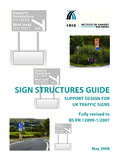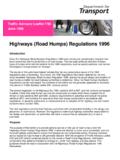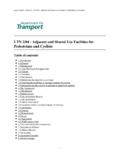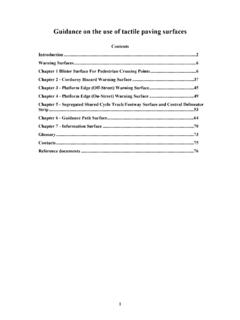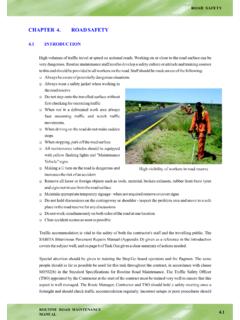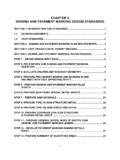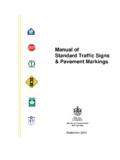Transcription of DMRB VOLUME 8 SECTION 2 PART 1 - TA 58/92 - …
1 THE HIGHWAYS AGENCY TA 58/92 . Incorporating Ammendment No. 1, dated April 1994. THE SCOTTISH OFFICE DEVELOPMENT DEPARTMENT. THE WELSH OFFICE. Y SWYDDFA GYMREIG. THE DEPARTMENT OF. THE ENVIRONMENT FOR NORTHERN IRELAND. traffic Signs and road Markings for Lane Gains and Lane Drops on All-Purpose Dual Carriageway and Motorway Trunk Roads Summary: This Advice Note recommends the type of traffic signs and road markings to be used at locations where traffic lanes are gained or dropped in either permanent or temporary situations. This Advice Note provides advice on specification requirements for use in public purchasing contracts. It does not lay down legislative requirements for products and material used in highway construction in the United Kingdom.
2 VOLUME 8 SECTION 2. Part 1 TA 58/92 Registration of Amendments REGISTRATION OF AMENDMENTS. Amend Page No Signature & Date of Amend Page No Signature & Date of No incorporation of No incorporation of amendments amendments ELECTRONIC COPY - NOT FOR USE OUTSIDE THE AGENCY. June 1992 PAPER COPIES OF THIS ELECTRONIC DOCUMENT ARE UNCONTROLLED. VOLUME 8 SECTION 2. Registration of Amendments Part 1 TA 58/92 . REGISTRATION OF AMENDMENTS. Amend Page No Signature & Date of Amend Page No Signature & Date of No incorporation of No incorporation of amendments amendments ELECTRONIC COPY - NOT FOR USE OUTSIDE THE AGENCY. PAPER COPIES OF THIS ELECTRONIC DOCUMENT ARE UNCONTROLLED June 1992. DESIGN MANUAL FOR ROADS AND BRIDGES. VOLUME 8 traffic SIGNS AND.
3 LIGHTING. SECTION 2 traffic SIGNS AND. road MARKINGS. PART 1. TA 58/92 . traffic SIGNS AND road . MARKINGS FOR LANE GAINS AND. LANE DROPS ON ALL-PURPOSE. DUAL CARRIAGEWAYS AND. MOTORWAY TRUNK ROADS. Contents Chapter 1. Introduction 2. Permanent Lane Gain 3. Permanent Lane Drop 4. Temporary Lane Gain/Lane Drop 5. General Requirements 6. References 7. Enquiries Appendix 1 Permanent Signs Appendix 2 Temporary Signs for Roadworks Appendix 3 Tables Appendix 4 Diagrammatic road Layouts ELECTRONIC COPY - NOT FOR USE OUTSIDE THE AGENCY. June 1992 PAPER COPIES OF THIS ELECTRONIC DOCUMENT ARE UNCONTROLLED. VOLUME 8 SECTION 2 Chapter 1. Part 1 TA 58/92 Introduction 1. INTRODUCTION. General Scope There are two main types of situation where This Advice Note recommends the type of traffic lanes are gained or dropped: traffic signs and road markings to be used on all purpose dual carriageway and motorway trunk roads at i.
4 At junctions where traffic streams come locations where there are lane gains and lane drops. together or separate with an associated gain or loss of one or more traffic lanes; The document does not cover the justification of the construction of a lane gain/drop provision. For ii. on lengths of carriageway where a policy guidance on such matters reference should be widening or narrowing occurs involving the made to TD 22 (DMRB ) (Ref 2) and TA 48 (DMRB. addition or loss of one or more full width ) (Ref 3). TD 22 and TA 48 are due to be revised traffic lanes. (In general, this will apply to mid 1992. temporary situations only - see ). Siting distances quoted in this document should The variation of the number of carriageway be regarded as applicable in ideal situations.
5 They may lanes over specific sections of route to meet particular need to be varied to suit particular circumstances, for traffic management demands brings with it different example, the location of other signs. signing needs beyond those covered in existing advice. Chapter 4 of the traffic Signs Manual (1986) Implementation [paragraphs and ] (Ref 1) deals with Warning Signs for use at junctions where the joining stream of This Advice Note should be used forthwith on traffic may be required to concede priority to the all schemes for the construction, improvement and "through" traffic stream. maintenance of trunk roads, including motorways, currently being prepared provided that, in the opinion of The situation where lanes are gained or the Overseeing Department, this would not result in dropped is not as straightforward.
6 A need has been significant additional expense or delay progress. identified for additional new traffic signs to be provided Design organisations should confirm its application to at these locations to ensure that drivers understand the particular schemes with the Overseeing Department. road layout, to prepare them for the traffic movements they are likely to encounter and manoeuvres they will have to make. Where drawings and specifications for signs described in this Advice Note require that materials or products shall comply with a British Standard, these requirements shall be satisfied by compliance with a relevant national or governmental standard of any member state of the European Community, provided that the standard in question offers guarantees of safety, suitability and fitness for purpose equivalent to those offered by the British Standard specified.
7 The advice given in this document will eventually be incorporated into the revised traffic Signs Manual. ELECTRONIC COPY - NOT FOR USE OUTSIDE THE AGENCY. June 1992 PAPER COPIES OF THIS ELECTRONIC DOCUMENT ARE UNCONTROLLED 1/1. VOLUME 8 SECTION 2 Chapter 2. Part 2 TA 58/92 Permanent Lane Gain 2. PERMANENT LANE GAIN. At Junctions Diagram 1004 for a distance commencing at least 200 metres prior to the merge nose tip and When a lane is gained at a junction there are continuing for at least 200 metres beyond the two major objectives in providing signs: tip. i. to ensure that joining traffic proceeds Where a two lane entry slip road joins the main ahead in the additional lane without impeding carriageway but there is only one additional main the flow of traffic on the main carriageway; carriageway lane available (Appendix 4 Diags 3 and 4), there are three methods available to allow this merging ii.
8 To alert drivers on the main movement onto the additional lane. carriageway to the effect that fast moving traffic will suddenly appear on their left-hand i. The two lane slip road is subjected to a side in a parallel and additional traffic lane. preliminary merge in advance of the back of the merge nose. In this case, signs to Figures 5. To meet these demands new sign designs have or 6, as appropriate, should be used to indicate been developed. These are shown in Appendix 1 to joining traffic that one slip lane is Figures 1 to 8. discontinued. These signs should be sited at each side of the joining carriageway 100 metres Guidance on the detailed deployment of these and 210-280 metres in advance of the back of new traffic signs, existing traffic signs and road the merge nose.
9 Markings for various lane gain junction configurations is given below. Signs to Figure 3 should be placed on the left hand side of the joining slip lane 50 metres in Where the number of lanes gained equals the advance of the merge nose tip. Signs to Figure number of entry slip lanes (Appendix 4, Diags 1 and 2), 1 should be sited on the left hand side of the signs to Figure 1 or Figure 2, as appropriate, should be main carriageway 50 metres and 295-355. placed on the main carriageway and sited on the left metres in advance of the back of the merge hand side to indicate to through traffic that one or two nose to indicate to through traffic that one lane lanes will be added to the through carriageway on the will be added. left hand side.
10 These signs should be sited 50 metres and 295-355 metres in advance of the back of the merge ii. To reinforce the message conveyed by nose. the signs, all road markings to Diagram 1005 of TSRGD should be replaced by markings to i. Signs to Figure 3 or Figure 4, as Diagram 1004. These markings should appropriate, should also be placed on the commence at the first sign to Figure 5 or 6 on joining carriageway to indicate to joining the slip road and at least 200 metres prior to the traffic that one or two extra lanes will be merge nose tip on the main carriageway. The available for that traffic when it reaches the markings should be continued for at least 200. main carriageway. Signs to Figure 3 should be metres beyond the merge nose tip or to the sited on the left hand side only but signs to termination of the merge taper, whichever is Figure 4 should be sited on each side of the the greater.
